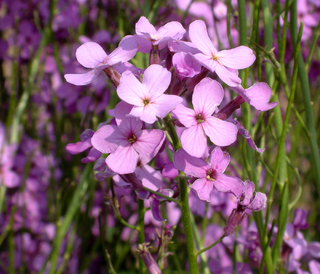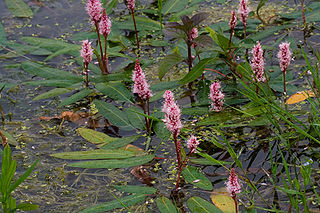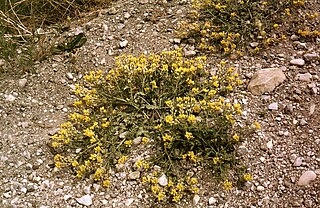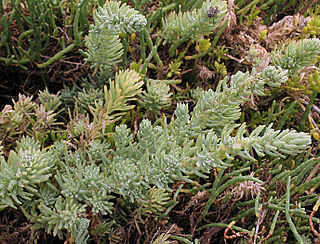
Hesperis matronalis is a herbaceous plant species in the mustard family, Brassicaceae. It has numerous common names, including dame's rocket, damask-violet, dame's-violet, dames-wort, dame's gilliflower, night-scented gilliflower, queen's gilliflower, rogue's gilliflower, summer lilac, sweet rocket, mother-of-the-evening, and winter gilliflower.

Alchemilla alpina, commonly known as alpine lady's-mantle, is an arctic-montane herbaceous perennial plant native to Europe and Southern Greenland.

Cerastium arvense is a species of flowering plant in the pink family known by the common names field mouse-ear and field chickweed. It is a widespread species, occurring throughout Europe and North America, as well as parts of South America. It is a variable species. There are several subspecies, but the number and defining characteristics are disputed.

Lathyrus littoralis is a species of wild pea known by the common name silky beach pea. It is native to the coastline of western North America from British Columbia to California. It is a resident of beaches and dunes.

Potentilla recta, the sulphur cinquefoil or rough-fruited cinquefoil, is a species of cinquefoil. It is native to Eurasia but it is present in North America as an introduced species, ranging through almost the entire continent except the northernmost part of Canada and Alaska.
Boechera cobrensis is a species of flowering plant in the mustard family known by the common names Masonic rockcress and sagebrush rockcress. It is native to the western United States from eastern California to Wyoming, where it is found in sandy habitat, especially sagebrush. This is a perennial herb growing several erect, slender stems to heights near half a meter from a branching caudex. The plant forms a narrow clump with a base of narrow, linear, densely hairy leaves up to 5 centimeters long. There are also a few slightly shorter leaves clasping the stems at intervals. The top of each stem is occupied by an inflorescence of small, nodding flowers with dull yellowish sepals and white petals. The flowers give way to fruits which are narrow, straight siliques up to 4 centimeters long containing winged seeds.

Polemonium chartaceum is a rare species of flowering plant in the phlox family known by the common names Mason's Jacob's-ladder and Mason's sky pilot. It is native to California, where it has a disjunct distribution. It occurs in the Klamath Mountains as well as the ranges east of the Sierra Nevada, including the White Mountains, where its distribution extends just into Nevada. It is a plant of high elevations, growing in exposed, rocky mountain slope habitat such as talus and alpine fellfields.

Persicaria amphibia is a species of flowering plant in the knotweed family known by several common names, including longroot smartweed, water knotweed, water smartweed, and amphibious bistort. It is native to much of North America, Asia, Europe, and parts of Africa, and it is known elsewhere as an introduced species and sometimes a noxious weed.

Rorippa columbiae is a species of flowering plant in the mustard family known by the common names Columbian yellowcress and Columbia yellow cress.

Silene bernardina is a species of flowering plant in the pink family known by the common name Palmer's catchfly.

Silene lemmonii is a species of flowering plant in the pink family known by the common name Lemmon's catchfly.
Silene marmorensis is a rare species of flowering plant in the pink family known by the common names Marble Mountain catchfly, Marble Mountain campion, and Somes Bar campion. It is endemic to the southern Klamath Mountains of northern California, where it grows in mountain woodlands and forests. It is a perennial herb producing several stems and shoots from a woody, branching caudex and thick taproot. The hairy, glandular stems grow erect to a maximum height near 40 centimeters. The lance-shaped leaves are a few centimeters long and are borne in pairs, the lowermost drying early. The inflorescence is a terminal cyme of flowers at the top of the stem, and some flowers may occur in the leaf axils. Each flower has a hairy, veined calyx of fused sepals. The flowers bloom at night, the five pinkish or green-tinged petals opening at the tip of the calyx.
Silene menziesii is a species of flowering plant in the pink family known by the common names Menzies' campion and Menzies' catchfly. It is native to western North America from Alaska through the western half of Canada to the southwestern United States. It can be found in many types of habitat and it is quite common in much of its range. It is variable in morphology and there are a number of varied subtaxa. In general, it is a perennial herb growing from a caudex, appearing matlike, decumbent, or erect, with stems a few centimeters to over half a meter long. It is usually hairy in texture, with upper parts bearing sticky glandular hairs. The leaves are lance-shaped, oppositely arranged in pairs, and a few centimeters in length, upper leaves usually smaller than lower. Flowers may occur in a cyme at the top of the stem, or in leaf axils, or both. Each is encapsulated in a hairy, veined calyx of fused sepals. The petals are white with two lobes at the tips. The plant is dioecious with male and female plants producing different flowers. The male and female flower types look the same externally; the stamens are reduced in female plants and the stigmas are reduced in the male.

Silene sargentii is a species of flowering plant in the pink family known by the common name Sargent's catchfly. It is native to the western United States, where it is known from the mountain ranges straddling the California-Nevada border east of the Sierra Nevada. It is also known from one disjunct occurrence in central Washington. It grows in rocky mountain habitat in subalpine and alpine climates. It is a perennial herb growing from a woody, branching caudex and taproot, sending up several decumbent or erect stems and shoots. It grows no more than about 20 centimeters tall, often taking a clumpy form. The fleshy leaves are widely lance-shaped and a few centimeters in length, most of them occurring around the caudex. Each flower is encapsulated in a hairy, glandular calyx of fused sepals which has stark purple veining. The petals are white to deep pink and each has two or more rounded or pointed lobes at the tip.
Silene suksdorfii is a species of flowering plant in the pink family known by the common names Suksdorf's silene, Suksdorf's catchfly and Cascade alpine campion. It is native to the Pacific Northwest of the United States, where it occurs from Washington and Idaho to northern California. It is mainly an alpine species, growing in the talus of high mountain slopes. It can also be found below the tree line in forested subalpine habitat. It is a squat perennial herb producing several erect stems from a leafy, woody caudex. It generally takes a clumpy form. The stems grow up to 10 or 15 centimeters tall and are hairy in texture, with glandular, sticky areas on the upper parts. The leaves occur in tufts around the caudex. They are fleshy and coated in soft hairs. Solitary flowers arise on erect peduncles. Each is encapsulated in an inflated calyx of fused sepals, which is starkly purple-veined and has purplish glandular hairs. The petals are white or purple-tinged and have two lobes at their tips and appendages at their bases.

Suaeda taxifolia is a species of flowering plant in the amaranth family known by the common name woolly seablite.

Potentilla villosa is a species of flowering plant in the rose family, Rosaceae. Its common names include villous cinquefoil, northern cinquefoil, and hairy cinquefoil. It is native to northwestern North America, where its distribution extends from Alaska to Alberta to Oregon. There are records from eastern Asia.

Packera franciscana is a rare species of flowering plant in the aster family known by the common name San Francisco Peaks groundsel, or San Francisco Peaks ragwort. It is endemic to Arizona in the United States, where it is known only from the San Francisco Peaks in Coconino County. It is threatened by recreational activities in its habitat. It is a federally listed threatened species of the United States.

The flora of the U.S. Sierra Nevada alpine zone is characterized by small, low growing, cushion and mat forming plants that can survive the harsh conditions in the high-altitude alpine zone above the timber line. These flora often occur in alpine fell-fields. The Sierra Nevada alpine zone lacks a dominant plant species that characterizes it, so may or may not be called a vegetation type. But it is found above the subalpine forest, which is the highest in a succession of recognized vegetation types at increasing elevations.

Smelowskia americana is a species of Smelowskia known by the common names alpine smelowskia, Siberian smelowskia, and American false candytuft. Native to mountain ranges of western North America including the Olympic Mountains and Cascade Range of Washington and the Rocky Mountains of British Columbia and Alberta south to Colorado, it occurs on rocky outcrops and talus at subalpine and alpine elevations, i.e., from 1,300–4,000 metres (4,300–13,100 ft), and blooms from late May until early September.


















